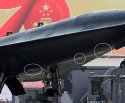The most heated part is the nose cone, and the composite material can withstand 350 degrees celsius as per the exhibit sample. This part creates a shockwave shadow for the rest of WZ-8 so as the heat is not a big issue.
View attachment 55877
The circles on the belly of WZ-8 indicate some windows for communication antennas (similar to those on top, especially the one behind the nose cone).
View attachment 55878
When WZ-8 flips during the high-speed cruise, the main radar equipment on the back can scan the earth surface.







